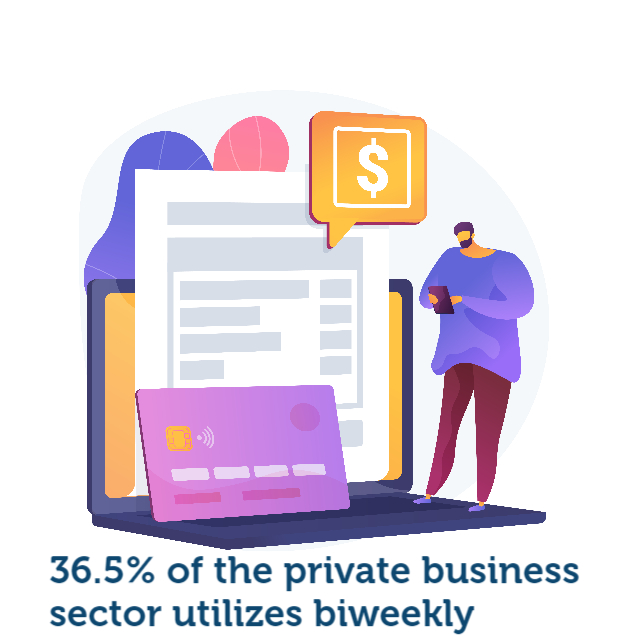
Employee Benefits Report: Payroll
From behind-the-scenes support to the forefront of strategic HR innovation, payroll systems are evolving into indispensable tools for transforming the employee experience and driving organizational success.

There are four common ways a company can pay its workers: weekly, biweekly, monthly, and semi-monthly.
When choosing the best fit, a company must make two considerations. First, what is the easiest and fastest way that the HR team can process paychecks? And, what works best for the employees?
When a company pays its employees every other week on a specific day is biweekly pay. For example, many companies decide to pay their workers every two weeks on a Friday, and they do so consistently even though pay dates will differ each month, as opposed to where they would remain the same each month with semi-monthly pay.
Biweekly payments are currently the most popular option in the US.
According to the US Bureau of Labor Statistics, 36.5% of the private business sector utilizes biweekly payments.

There are 26 biweekly pay periods in a year where workers get paid every other week.
Most work weeks are only five days long; therefore, pay periods rotate on a seven-day cycle. A year has 52 weeks, which divided by two equals 26.
Although 26 biweekly pay periods fit almost perfectly into a calendar year, the first pay cycle of each year does not always begin on January 1.
As a result, depending on the dates on which the pay periods begin and end, sometimes there can be one extra or one fewer biweekly pay period each calendar year.
The difference between biweekly and semi-monthly pay is the number of times a worker gets paid during a year. When paid biweekly, the worker receives 26 paychecks per year; when paid semi-monthly, the worker gets 24 paychecks a year.
So, why is there a difference?
A worker paid semi-monthly gets paid every 15th of the month and the last day of the month, as opposed to a biweekly worker that gets paid every other week on a specific day of the week.
Since some months have more weeks, biweekly paid workers can receive three paychecks in those months. Therefore, here lies the difference in the number of paychecks a worker gets annually.
Employees can benefit from biweekly payroll.
They become accustomed to being paid approximately twice per month on the same weekday and then receive two extra paychecks each year, compared to semi-monthly workers.
Furthermore, employees can more easily budget for cash receipts every other Friday rather than receipts that may be accelerated or delayed due to the presence of weekends and holidays.
Hence, it gives them a sense of security that there will be money in their bank account every second Friday. They don’t have to worry about it or calculate their payday every month, and by having consistency in this regard, employees can better manage their finances.
Though employees have smaller paychecks each pay period than those on a semi-monthly pay schedule, biweekly pay equals more paydays.
Even if an employee makes the same amount of money regardless of pay frequency, biweekly pay makes it easier to reduce debt or save money in the months when the employee receives an extra paycheck.
While salaried employees are exempt from collecting overtime, hourly employees are not. Compared to businesses that operate on a semi-monthly pay schedule, companies that operate on a biweekly pay schedule make it easier to calculate overtime pay.
Let’s assume that an employee’s extra hours fall between two semi-monthly pay periods. In that case, businesses must make adjustments to account for this, which can be too complex to grasp for the person in charge of payroll.
From an organizational standpoint, preparing a biweekly payroll is easier for payroll staff because processing steps always occur on the same day each week.
Biweekly pay is common in three industries:
According to the Department of Labor, different patterns emerge in the distribution of pay period length by size class.
The percentage of private businesses that use a biweekly pay period is lowest in the smallest size class companies (1–9 employees), which rises as the size class grows.
Over 70% of businesses in the largest class (more than 1,000 workers) pay biweekly.
To summarize, as the size of the organizations grows, private businesses use a biweekly pay period more frequently.
As a result, 72.9% of private businesses in the largest size class pay their employees every two weeks, and the length of the pay period is more consistent in these businesses.
Choosing a pay frequency is crucial for businesses because they must consider state laws, employee needs, operational budget, and the HR team’s effectiveness.
HR’s entire infrastructure revolves around providing better working conditions that improve their ability to produce more significant results. Hence, before deciding on a monthly, semi-monthly, biweekly, or weekly pay, it is best to consult with the company’s HR department to know the limitations and possibilities of the organization.
While some pay schedules, such as biweekly, may be more convenient for employees, others, such as monthly or semi-monthly, provide more accurate calculations on the managerial end.
As a result, after HR’s input, it is necessary to weigh the benefits and drawbacks of each and determine which is best for the organization.
Browse our curated list of vendors to find the best solution for your needs.
Subscribe to our newsletter for the latest trends, expert tips, and workplace insights!

From behind-the-scenes support to the forefront of strategic HR innovation, payroll systems are evolving into indispensable tools for transforming the employee experience and driving organizational success.

Explore the perks and potential concerns of payroll tax holiday and their significance for workers and companies.

While the federal minimum wage sparks a debate about whether or not it needs to be increased, one thing is certain – business owners must stay up-to-date with the latest labor law changes.

While Paycom has set a high standard in payroll services, our guide to its top competitors and alternatives reveals other innovative solutions that can transform your HR and payroll operations.
Used by most of the top employee benefits consultants in the US, Shortlister is where you can find, research and select HR and benefits vendors for your clients.
Shortlister helps you reach your ideal prospects. Claim your free account to control your message and receive employer, consultant and health plan leads.